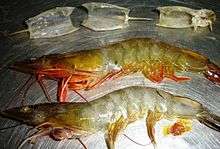Whiteleg shrimp
| Litopenaeus vannamei | |
|---|---|
 | |
| Scientific classification | |
| Kingdom: | Animalia |
| Phylum: | Arthropoda |
| Subphylum: | Crustacea |
| Class: | Malacostraca |
| Order: | Decapoda |
| Suborder: | Dendrobranchiata |
| Family: | Penaeidae |
| Genus: | Litopenaeus |
| Species: | L. vannamei |
| Binomial name | |
| Litopenaeus vannamei (Boone, 1931) [1] | |
| Synonyms | |
|
Penaeus vannamei Boone, 1931 | |
Whiteleg shrimp (Litopenaeus vannamei, formerly Penaeus vannamei), also known as Pacific white shrimp or king prawn, is a variety of prawn of the eastern Pacific Ocean commonly caught or farmed for food.
Description
L. vannamei grows to a maximum length of 230 mm (9.1 in), with a carapace length of 90 mm (3.5 in).[2] Adults live in the ocean, at depths to 72 m (236 ft), while juveniles live in estuaries.[2] The rostrum is moderately long, with 7–10 teeth on the dorsal side and two to four teeth on the ventral side.[2]
Distribution and habitat
Whiteleg shrimp are native to the eastern Pacific Ocean, from the Mexican state of Sonora to as far south as northern Peru.[2] It is restricted to areas where the water temperatures remain above 20 °C (68 °F) throughout the year.[3]
Fishery and aquaculture
During the 20th century, L. vannamei was an important species for Mexican inshore fishermen, as well as for trawlers further offshore.[2] In the late 20th century, the wild fishery was overtaken by the use of aquaculture; this began in 1973 in Florida using prawns captured in Panama.[3] In Latin America, the culture of L. vannamei showed peaks of production during the warm El Niño years, and reduced production during the cooler La Niña years, due to the effects of disease.[3] Production of L. vannamei is limited by its susceptibility to various diseases, including white spot syndrome, Taura syndrome, infectious hypodermal and haematopoietic necrosis, baculoviral midgut gland necrosis, and Vibrio infections.[3] By 2004, global production of L. vannamei approached 1,116,000 t, and exceeded that of Penaeus monodon.[3]
In 2010, Greenpeace International has added the whiteleg shrimp to its seafood red list. This lists fish that are commonly sold in supermarkets around the world, and which have a very high risk of being sourced from unsustainable fisheries.[4] The reasons given by Greenpeace were "destruction of vast areas of mangroves in several countries, overfishing of juvenile shrimp from the wild to supply shrimp farms, and significant human rights abuses".[4]
References
- ↑ "Litopenaeus vannamei (Boone, 1931)". Integrated Taxonomic Information System. Retrieved June 8, 2011.
- 1 2 3 4 5 "Penaeus vannamei (Boone, 1931)". Species Fact Sheets. Food and Agriculture Organization. Retrieved June 8, 2011.
- 1 2 3 4 5 "Penaeus vannamei (Boone, 1931)". Cultured Aquatic Species Information Programme. Food and Agriculture Organization. Retrieved June 8, 2011.
- 1 2 Greenpeace International Seafood Red list
External links
| Wikimedia Commons has media related to Whiteleg shrimp. |